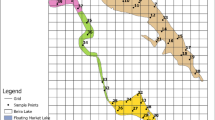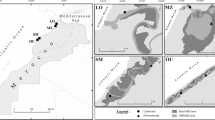Abstract
In this study, variance analysis technique on unbalanced data was examined, and in this sense, Type II (fitting constants) methods were studied. The aim of this study was to show that meaningful evaluations can be performed even in unbalanced conditions and to contribute to the present investigations in biological area. In the implementation part of the study, the juvenile leaf densities of Posidonia oceanica—which is a sea grass that grows in Izmir Bay, and has very important ecological effects—in various regions and in various depths were determined. The results revealed that depth affect number of juvenile leaf (d.f. = 3, F = 523.90, R 2 = 0.998, p < 0,01). There were significant differences among region (d.f. = 3, F = 41.53, p < 0.01), site (d.f. = 1, F = 19.65, p < 0.01). As a result of Tukey ANOVA test it can be said that there were significant differences among Urla–Gülbahçe (p < 0.001), Urla–Foça (p < 0.001), Karaburun–Gülbahçe (p < 0.001), Karaburun–Foça (p < 0.001). It was found that Foça had the highest juvenile leaf counts (782.15 ± 435.71) whereas Urla had the lowest juvenile leaf counts (231.46 ± 175.67). The mean juvenile leaf counts in Izmir was (496.23 ± 377.61). it can be said that juvenile leaf counts in Karaburun(Island) had (448.13 ± 250.85), and Foça(Island) had (888.65 ± 497.39).



Similar content being viewed by others
References
Alcoverro, T., Cerbian, E., & Ballesteros, E. (2001). The photosynthetic capacity of the seagrass Posidonia oceanica: influence of nitrogen and light. Journal of Experimental Marine Biology and Ecology, 261, 107–120. doi:10.1016/S0022-0981(01)00267-2.
Alcoverro, T., Manzanera, M., & Romero, J. (1998). Seasonal and age-dependent variability of Posidonia oceanica (L.) Delile photosynthetic parameters. Journal of Experimental Marine Biology and Ecology, 230, 1–13. doi:10.1016/S0022-0981(98)00022-7.
Boyacioglu, H., & Baskan, O. (2007). Unbalanced factorial design: use of type I, type II and type III sums of squares. Online Journal of Bioinformatics, 8(1), 45–55.
Dural, B., & Pergent, G. (2001). Phenology of Posidonia oceanica along the Izmir coastline (Turkey). Proceedings of the Fifth Intern.Conf.on the Meditt.Coast. Environ. MEDCOAST 01, E.Özhan (Edit.) 23–27 October, pp: 579–584 Hammamet, Tunisia.
Giraud, G. (1979). Sur une methode de mesure et de comptage des structures foliares de Posidonia oceanica (Linnaeus) Delile. Bulletin du Musée d'histoire Naturelle de Marseille, 39, 33–39.
Guidetti, P. (2001). Detecting environmental impacts on the Mediterranean seagrass Posidonia oceanica L. Delile: the use of reconstructive methods in combination with beyond BACI designs. Journal of Experimental Marine Biology and Ecology, 260, 27–39. doi:10.1016/S0022-0981(01)00245-3.
Guidetti, P., & Fabiane, M. (2000). The use of lepidochronology to assess the impact of terrigenous discharges on the primary leaf production of the mediterranean seagrass Posidonia oceanica. Marine Pollution Bulletin, 40, 449–453. doi:10.1016/S0025-326X(99)00229-5.
Hemminga, M. A., Marba, N., & Stapel, J. (1999). Leaf nutrient resorption, leaf lifespan and the retention of nutrients in seagrass systems. Aquatic Botany, 65, 141–158. doi:10.1016/S0304-3770(99)00037-6.
Langsrud, O. (2003). ANOVA for unbalanced data: use type II instead of type III sums of squares. The Journal of Statistics and Computing, 13, 163–167. doi:10.1023/A:1023260610025.
Manzanera, M., Alcoverro, T., & Romero, J. (1998). The role of the remnant leaf sheaths scales attached to the Posidonia oceanica L. Delile rhizomes. Journal of Experimental Marine Biology and Ecology, 223, 257–270. doi:10.1016/S0022-0981(97)00184-6.
Molenaar, H., Barthelemy, D., Reffye, P., Meinesz, A., & Mialet, I. (2000). Modelling architecture and growth patterns of Posidonia oceanica. Aquatic Botany, 66, 85–99. doi:10.1016/S0304-3770(99)00071-6.
Pergent-Martini, C., & Pergent, G. (1994). Lepidochronological analysis in the Mediterranean seagrass Posidonia oceanica: state of the art and future developments. Oceanologica Acta, 17, 673–681.
Sanchez-Jerez, P., Cebrian, C. B., & Espla, A. (1999). Comparison of the epifauna spatial distribution in Posidonia oceanica, Cymodocea nodosa and unvegetated bottoms: importance of meadow edges. Acta Oceanologica, 20, 391–405. doi:10.1016/S1146-609X(99)00128-9.
Acknowledgements
This study was funded by the Scientific and Technical Research Council of Turkey and Aegean University Research Fund (TBAG-1638 197T032).
Author information
Authors and Affiliations
Corresponding author
Rights and permissions
About this article
Cite this article
Boyacioglu, H., Dural, B. The Statistical Investigation on Posidonia Oceanica (L.) Delile Meadows in Izmir, Turkey. Environ Model Assess 14, 769–772 (2009). https://doi.org/10.1007/s10666-008-9178-y
Received:
Accepted:
Published:
Issue Date:
DOI: https://doi.org/10.1007/s10666-008-9178-y




